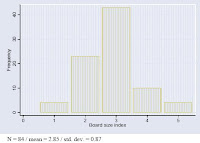
A new working paper from the Fund- Central Bank Boards Around the World: Why Does Membership Size Differ? The conclusion excerpted below;
“Recent research emphasizes the importance of central bank design for the success of monetary policy. One of the features that have received particular interest is the membership size of the central bank’s decision-making body—that is, how many people should decide whether to take measures to achieve a specified monetary policy target?
From a theoretical point of view, the optimal size of an MPC depends on the costs and benefits. On the benefit side, larger MPCs promise improvements in information processing along the lines of Condorcet’s jury theorem. At the same time, decision making typically becomes more difficult and time consuming as the number of MPC members increases. Also, members may have a stronger incentive to “freeride” on the information-processing efforts of others in larger MPCs. Other factors influencing the optimal size of MPCs include political forces: both the fact that large MPC size may increase its ability to resist political pressures as well as the fact that the size will reflect the political balance of power. Finally, if central bank designers take a holistic view of central bank organization, other parameters of central bank design, such as the term length of MPC members, may be systematically related to MPC size as well. Since factors affecting optimal board size are likely to differ across countries (e.g., the information-processing requirement might vary with the size and diversity of the economy), it seems reasonable to assume also that “the efficient size of a policy committee might vary across countries” (Goodfriend 2005, p. 85).
Around the world, central bank boards do, indeed come, in different sizes. Although New Zealand, for instance, the governor alone is responsible for policymaking, the European Central Bank (ECB) Governing Council currently comprises 18 members. Moreover, the pending increase in euro area membership has triggered a preemptive ECB reform that generally limits the overall number of voting members to 21. This, however, still seems to be a relatively large number compared with the membership size of other central bank decisionmaking bodies such as the U.S. Federal Reserve’s Federal Open Market Committee. The average MPC in our sample of central banks has 7–9 members.
In this paper, we characterize differences in the structure of central bank governance based on a dataset that covers the (de jure) membership size of 84 central bank boards around the world at the end of 2003 that make decisions on whether to increase or decrease interest rates to achieve a specified target. We find that board size is indeed significantly and plausibly correlated to various country and central bank characteristics. For instance, MPC size tends to increase with country size and population heterogeneity, thereby providing empirical support for the notion that central bank board size is affected by information-processing requirements. There is also evidence that MPC size is correlated to political institutions, with more democratic countries, where citizens participate more strongly in the selection of their governments, having, on average, larger boards. For some variables, we find a hump-shaped effect on MPC size.
Finally, although the size of the central bank’s policy committee has been the focus of much debate recently, there are indications that it should not be viewed as independent of other features of central bank design. MPC size is often associated with other central bank characteristics. For instance, central banks tend to have larger MPCs if they have more staff or higher operational expenditure. More importantly, countries with floating exchange rate regimes, which typically have more complicated monetary policy frameworks, also seem to have larger boards. Along similar lines, we find that more independent central banks often have larger MPCs. Furthermore, there is a negative relation between MPC size and the length of terms served by MPC members (at least at shorter term lengths). Viewed in conjunction with the results discussed previously, this suggests that the institutional setup of central banks may indeed be tailored to reflect country-specific factors.”
Related;
Central Bank Governance: A Survey of Boards and Management
Central Bank Autonomy, and Inflation and Output Performance in the Baltic States, Russia, and Other Countries of the Former Soviet Union, 1995-97
Independent Review of the Operation of Monetary Policy- Reserve Bank of New Zealand
Monetary policy in Asia: approaches and implementation
No comments:
Post a Comment